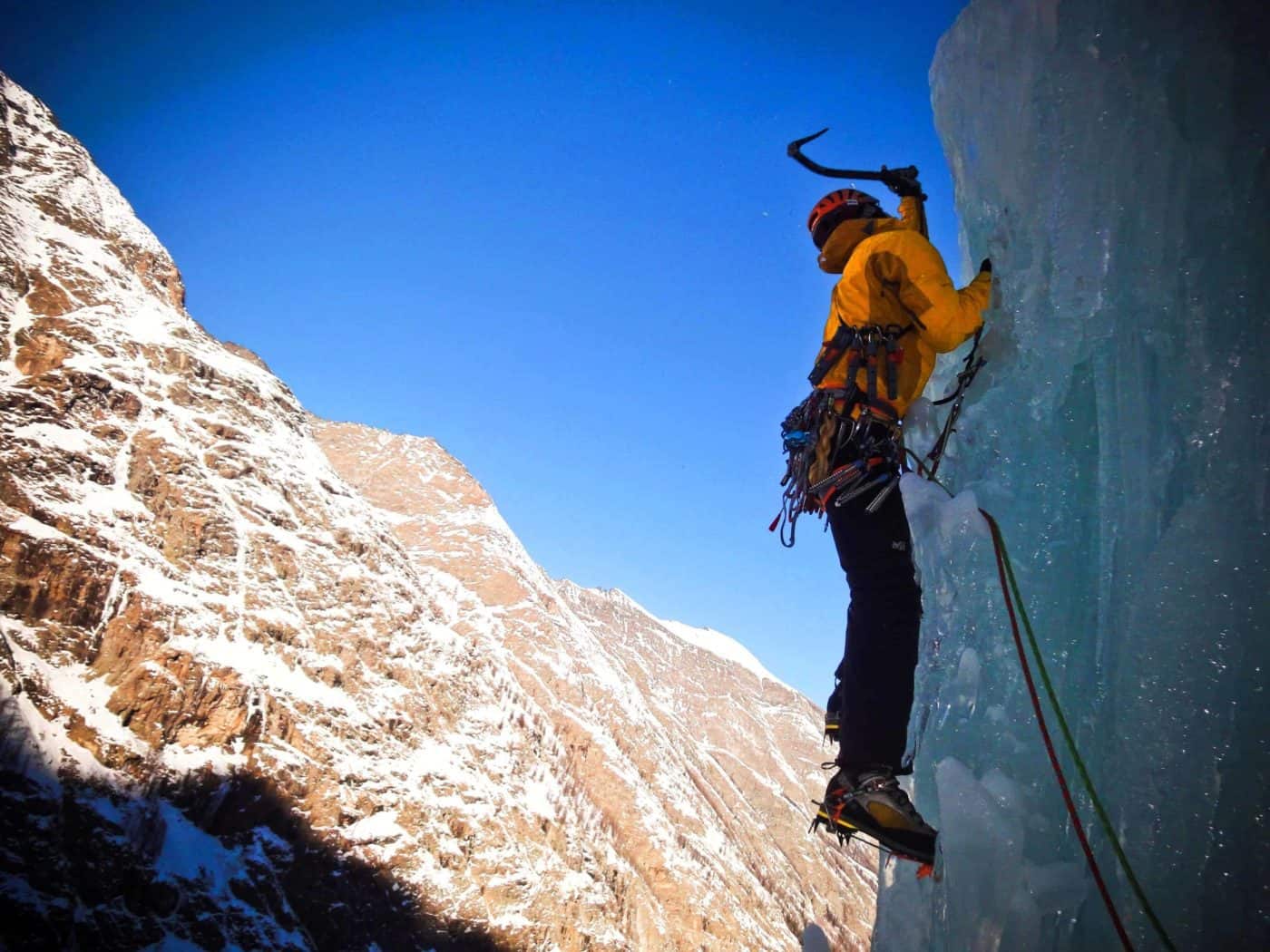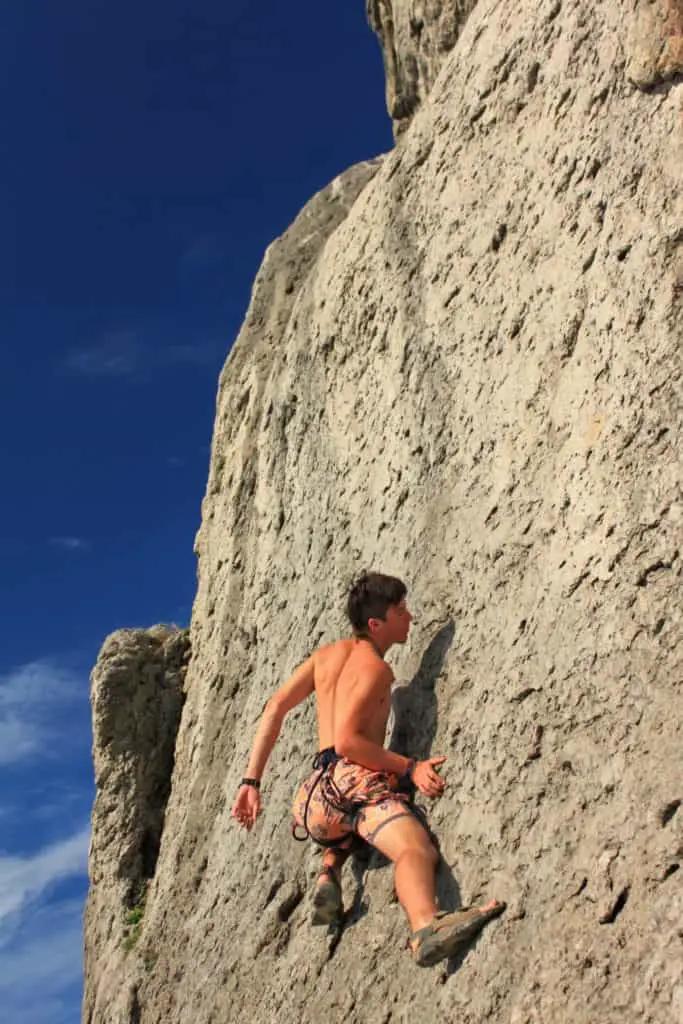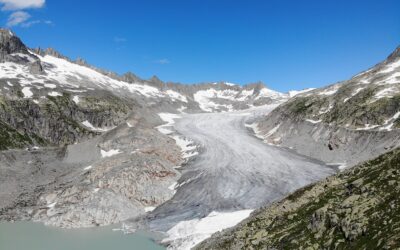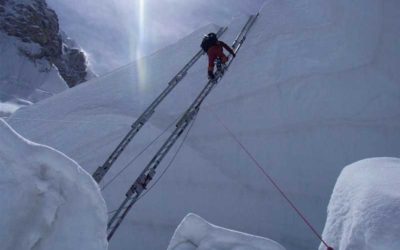
Ice climbing in Cogne. Photo from KSszilas
You’ve done loads of rock climbing and your thoroughly enjoy it. Now, you’re heading off on a holiday with some friends into ice climbing country. Why not give it a try? What’s the worst that could happen, right?
In summary, In Ice climbing you need more equipment and falling is more dangerous than in rock climbing. Routes on ice and rock have different grading because of the changing ice, and ice climbing routes tend to change. Moreover, the risk of getting hurt is lower when ice climbing, but ice climbing is riskier. Rock climbing is also more precise and technical, while ice climbing is simpler in theory.
In this article, I’ll explore the differences and similarities between rock climbing and ice climbing to shed some light on the matter. I aim to answer the burning question, is it easy to transition between rock climbing and ice climbing?
The Main Differences
Rock climbing and ice climbing is not the same thing. Here’s a list of some of the major differences between the two:
- In ice climbing, the rule is “the leader must never fall”. This is because, if crampons get caught on the ice, someone can get seriously hurt. In rock climbing, whether trad or sport, falling is par for the course.
- Ice climbing is much simpler than rock climbing, because you’re just swinging your tool. Rock climbing technique can get pretty tricky.
- Ice climbing is far riskier than rock climbing.
- In ice climbing, your probability of getting hurt is lower. This is because you practice extensively on top rope before leading a route. Here, you get enough experience in using your ice axe that most lead climbers can instantly tell whether a hold is good or not. In rock climbing, you start leading much sooner, rendering the probability of falling and getting seriously hurt much higher.
- Due to the nature of the climb, you have different belaying strategies for rock and ice climbing.
- Placing gear. In rock climbing, you have to really focus when placing trad gear, whereas you don’t have to be as skilled to place ice screws. Also, rock holds are where they are – you have to reach them and place your gear securely. In ice climbing, you place your ice screws pretty much anywhere you want.
- Leaving gear behind. In ice climbing, the gear you leave behind when you bail isn’t as expensive as when you do it in rock climbing.
- Rock climbing happens in both hot and cold weather, but hardly ever in sub-zero circumstances. Ice climbing, by its very nature, happens in extreme cold. Rock climbing also doesn’t really work when it’s too wet out, while ice climbing tends to be very wet.
- You wear way more stuff when you’re ice climbing than when you’re rock climbing, just because it’s so damn cold.
- Geographical area. Ice climbing can only happen in regions where enough solid ice forms and only while the ice is actually there. Rock climbing can happen just about anywhere.
- Route changes. When a rock climbing route gets a lot of traffic, it tends to get really slippery from being polished by everyone’s hands. Ice climbing routes get easier with increasing traffic, since ice becomes rougher and easier to scale.
- Since ice is forever changing, routes are graded based on their steepness and the type of ice, not on technical difficulty. Rock climbing routes are graded on the level of skill you need to send them.

Similarities between the two
There are many aspects of rock climbing and ice climbing that overlap. Here are some of them:
- Steep learning curve. If you want to lead climb intermediate routes, you’ll need to knuckle up and prepare for some hard work and potentially big falls.
- Overarching principles. The types of protection and gear you need along with body mechanics are the same for both rock climbing and ice climbing. So are anchoring practices.
- In both rock climbing and ice climbing, you use a rope, harness, quickdraws and belay devices.
- Both of these sports are assessed and rated by the UIAA (International Climbing and Mountaineering Federation).
- It’s dangerous, not matter what you’re climbing. Ice climbing routes are often beneath avalanche chutes, while in rock climbing, the danger of a rock fall is very real. Added to that, you have the actual danger of climbing and having a bad fall.
Climbing Rock vs Ice: Equipment Differences
In rock climbing, the amount of gear that you need is often weather dependent. If you’re going to an easily accessible area in the heat of summer, you basically need some flip flops to get to the crag, shorts, a t-shirt, sunscreen, helmet and a light pack with enough water and a snack. In the Scottish mountains, you need to take an entire pack with survival gear, regardless of the season.
In ice climbing, you’re always prepared for the worst weather. This is because you’re hitting the ice crags in the miserable season when the weather is highly unpredictable and you can get stuck in a snowstorm or avalanche at any point in time.
Added to this, you need a shootload of gear for ice climbing: crampons, two ice axes, a base layer and down jacket, headlamp and your actual climbing gear.
Here’s a list of some basic ice climbing gear:
- Crampons
- Good shoes, compatible with your climbing crampons
- Rope
- Harness
- Grigri or other belay device
- Ice axes (two of them)
- Ice screws
- Carabiners
- Slings to keep all your gear together and you attached to your safety points.
- Helmet
- Lots and lots of gloves. One pair for approach, two high-performance pairs for climbing and one pair for belaying, at least. Most people prefer taking some puffy mittens and extra pairs of warm gloves with.
- Warm clothes. Seriously. And you have to layer them cleverly if you want to conserve your body heat.
- Yes, you burn even in the snow. Sometimes because of it. If there’s even a weak amount of UV rays that hit the snow, they get reflected, causing you to get some serious sunburn.
Equipment needed for rock climbing is similar to that used for ice climbing, with some key differences:
- Rope
- Harness
- Grigri
- Carabiner
- Shoes: at least one pair for approach and one for climbing. Hardcore climbers use different shoes for different routes.
- Slings
- Helmet
- Sunscreen
- Trad gear, if you’re not doing sports climbing or bouldering
- Crash pad, if you’re bouldering
Technique Similarities and Differences
In rock climbing, you will work both your muscles and your heart, getting some cardio in while getting absolutely pumped on a technical route. You’re working against gravity and, on difficult routes, will often pause for quite a bit while you figure out what to do next.
In ice climbing, the idea is to work in a regular rhythm. This means that your heart will work hard with the cardio, but your muscles won’t necessarily experience as much fatigue as with rock climbing.
Ice Climbing is more dangerous than Rock Climbing (if you fall)
The most major switch in mind set and technique between rock climbing and ice climbing is related to falling.
In rock climbing, a lead fall is scary and potentially dangerous, but very common. Rock climbers expect to fall and do so often, with the belayer catching them before they hit anything bad.
In ice climbing, falling is not common and is very dangerous. You shouldn’t expect to fall and should climb in such a way that you don’t fall. This means not continuing the route when you get super pumped, since you will almost definitely fall then.
You would also work your way up to harder routes much slower than in rock climbing, since falling because you’re too pumped to hold on is what rock climbers tend to do.
Falling Rock vs Falling Ice
Another mindset change is related to falling objects. In rock climbing, it’s rare to have rock falls, especially on sports climbing routes that are very busy. For this reason, the belayer would stand where they can see the entire route best, regardless of the overhead conditions.
In ice climbing, however, falling ice is common and should be expected. The belayer should stand out of the way of falling ice, since getting hit by a large chunk of ice is potentially lethal.
Conclusion
While there are many similarities between ice climbing and rock climbing, they are two different sports and should be treated as such.
If you’re an ice climber transitioning to rock, or the other way around, it’s well worth it to get some professional coaching before you head out with a friend.
Make sure that you understand the basic technique and safety principles involved in each one of these before you hit the crag.
Now that you understand the major similarities and differences between ice climbing and rock climbing, why not try it out? Happy adventures!
Written by Felix
July 5, 2019

About me
Hi! I’m Felix. When I’m not spending time out in the mountains, I like to write about my hobbies. That is how Mountain Homies was created. On this site, I try to gather all the juicy information about Mountaineering that I have learned since I started. Happy adventures!
Recent Posts
The 10 Largest Glaciers In The World (Length, Location & More)
In this article, we’ll have a look at the ten most massive glaciers in the world (by length, not area). Some of these are accessible for hiking and climbing, while others are not…
3 Ways to Spot and Reveal a Crevasse (And Avoid It)
So, how do you spot a crevasse and – more importantly – avoid falling into one? In this article, I will have a look at what crevasses are and how to detect them…
5 Ways of Knowing If Your Climbing Shoes Are Too Big
It has almost become a prestige among climbers to be able to boast about how small and tight climbing shoes can be used. There is therefore a lot of talk…
Related Articles
3 Ways to Spot and Reveal a Crevasse (And Avoid It)
So, how do you spot a crevasse and – more importantly – avoid falling into one? In this article, I will have a look at what crevasses are and how to detect them…
5 Ways of Knowing If Your Climbing Shoes Are Too Big
It has almost become a prestige among climbers to be able to boast about how small and tight climbing shoes can be used. There is therefore a lot of talk…
3 Clever Ways of Crossing A Crevasse
When you’re mountaineering in snow country, you will undoubtedly encounter some crevasses. These are scary, since you don’t always spot them…
Stay Up to Date With The Latest News & Updates
Join Our Newsletter
The owner of this site is a participant in the Amazon Services LLC Associates Program, an affiliate advertising program designed to provide a means for sites to earn advertising fees by advertising and linking to amazon.com.




